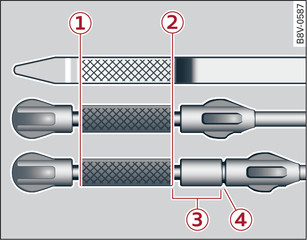|
The oil dipstick differs depending on the type of engine.
Please refer to the safety notes ►.
Park the vehicle on a level surface.
Switch off the warm engine.
Wait approx. two minutes.
Open the bonnet link►.
Pull out the oil dipstick Fig. ►,
wipe it with a clean cloth and insert it again, pushing it in as far as it will go.
Then pull the dipstick out again and check the oil level link►.
If the oil level is too low, add more engine oil link►.
Markings on oil dipstick Fig. 214►
|
|
-1-
|
When the oil level is near the marking -1- you must top up the engine oil. Please refer to
►. |
-2- -3- | Do NOT add engine oil. |
-4-
|
Do NOT add engine oil. Drive to a qualified workshop without delay and have the engine oil changed ►. |
- The engine oil must never drop below the marking -1- Fig. 214► - risk of engine damage!
- When topping up the engine oil, make sure that the oil level is not above the marking -2- Fig. 214►, as this may result in damage to the catalytic converter or to the engine. Do NOT start the engine. Contact a qualified workshop to extract the engine oil if necessary.
- Applies to vehicles which have an oil dipstick with area -3- Fig. 214►: If you run your vehicle on diesel fuel of poorer quality than EN 590 standard fuel, the fuel can get into the engine oil. In this case, the oil level gradually rises and the quality of the engine oil decreases. Once the oil level has reached the marking -4- or the indicator lamp
 has come on, the engine oil level must not be corrected by extracting the surplus oil - risk of engine damage! The engine oil must be changed link►.
has come on, the engine oil level must not be corrected by extracting the surplus oil - risk of engine damage! The engine oil must be changed link►.
Note
Depending on how you drive and the conditions in which the car is used, oil consumption can be up to 0.5 ltr./1000 km. Oil consumption is likely to be higher for the first 5,000 km. For this reason the engine oil level must be checked at regular intervals, preferably when refuelling and before a journey.

